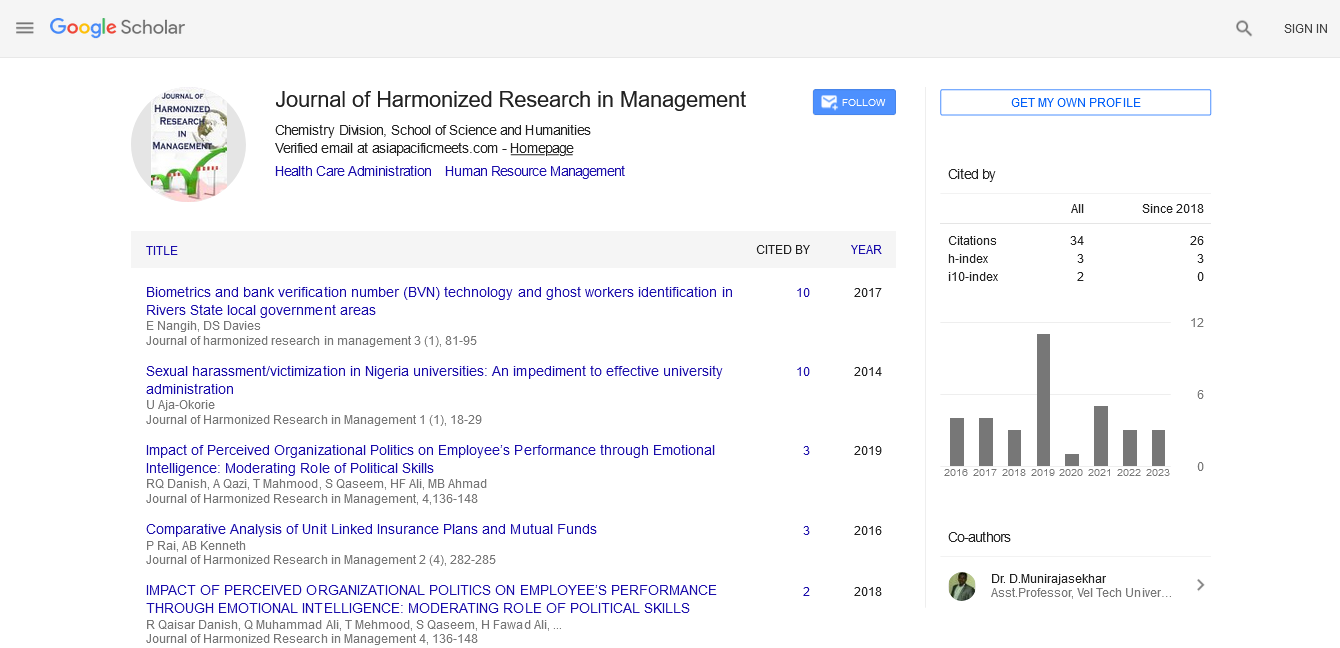Commentary - (2022) Volume 8, Issue 2
INTERACTIONS BETWEEN ORGANISATIONAL, SOCIAL, AND HUMAN CAPITAL IN NONPROFIT AND VOLUNTEER GROUPS
Chi Zhang*Received: Sep 01, 2022, Manuscript No. JHRM-22-77756; Editor assigned: Sep 05, 2022, Pre QC No. JHRM-22-77756 (PQ); Reviewed: Sep 19, 2022, QC No. JHRM-22-77756; Revised: Sep 27, 2022, Manuscript No. JHRM-22-77756 (R); Published: Oct 05, 2022, DOI: 10.30876/2354-5384.22.8.130
Description
In the pursuit of a social purpose, Non Profit and Voluntary Organizations (NPVOs) historically place a strong emphasis on the ideals of reciprocity, cooperation, and partnership. Though many NPVOs now compete for public service contracts, funders, sponsors, clients / consumers, personnel, and volunteers as a result of the marketization of the delivery of public services. In order to compete, NPVOs must accept marketization, “professionalise” management techniques, and create cutting-edge plans that increase organisational value. The development of competitive advantage and the production of stable income are the main objectives. It is frequently challenging to reconcile this marketoriented agenda, which is framed by New Public Management concepts, with the values and social purposes of NPVOs. But for NPVOs to survive, it is essential to manage the inherent conflicts between “purpose” and “market,” as well as economic unpredictability and shifting stakeholder priorities. Theoretical understanding of the effectiveness of NPVO techniques for managing these conflicts, how stakeholders experience and perceive them, and how organisational outcomes might be explained is currently insufficient. In order to make sense of the empirical data gathered in three case studies of NPVOs, we apply a systematic combination and abductive logic approach combined with a framework of Intellectual Capital (IC) to solve this theoretical deficiency. Through this method, we gain new insight into how the application of cutting-edge management practises that are primarily meant to achieve competitive advantage might result in unexpected organisational results.
Social media has grown in importance as a platform for community and nonprofit communications. Through two adoption theories Media Richness theory and Diffusion theory this study intends to ascertain how non-profit organisations have adopted and use Facebook as well as how Facebook motivates donors or volunteers to support non-profit organisations in the Libyan setting. Only non-profit organisations in Libya that are registered and supervised by the ministry of culture and civil society are covered in this study’s demographic since it focuses on the adoption and usage of social media. Facebook is the only social media platform available.
We have examined how the adoption of strategies in NPVOs permits virtuous, vacillating, or vicious organisational results in increasingly challenging funding circumstances using the Intellectual Capital framework. We discover that the relevance of social capital within the IC triad is especially significant within the setting of our instances by looking at how sources of human, organisational, and social capital interrelate in NPVOs. Its ability to make up for shortfalls in other capitals, especially organisational capital, reveals its centrality. It has been emphasised throughout this study that NPVOs may need to rely substantially on sources of social capital to provide services in a cutthroat and difficult environment. Existing emphasises how the NPVOs’ access to sources of social capital distinguish them from businesses in other industries and serve as their primary source of “organisational value.” The core tenet of our findings, however, suggests that when it comes to the provision of public services, particularly in a setting that is growing more competitive, the importance of social capital may actually be counterproductive if other kinds of capital also have dis-synergies.
In the end, our case study comparison shows that the relationships between organisational, social, and human capital can be compensatory as well as complimentary to maintain the organization’s functioning. The institutional and organisational setting will influence this dynamic. The generalizability of these findings is constrained by the dependence on qualitative interviews and focus groups in three case study organisations. Nevertheless, our application of the idea of IC contributes significantly and in a novel way to our understanding of how NPVOs adopt and carry out their strategies in the unstable NPVO sector environment marked by rising rivalry for limited resources. The study offers a compelling illustration of how crucial it is for businesses to “understand the value of knowledge resources and how to manage them,” and it is especially helpful for businesses that provide public services. In conclusion, an NPVO’s larger context must be taken into consideration while making decisions on how to innovate, exploit, and build the sources of human, organisational, and social capital.
Although there are many marketing implications that have been thought about in relation to social media marketing, the impact of antecedents of consumer brand engagement (telepresence, social presence, and involvement) and their repercussions for nonprofit organisations have received less attention. The primary goal of the current study is to investigate how Consumer Brand Engagement (CBE) (second-order), which in turn influences electronic word of mouth and desire to donate, is influenced by telepresence, social presence, and involvement. This article employed social media sites to evaluate the suggested model. We used a Facebook page that showcases non-profit brands using a sample of people who are not students. Discovered that telepresence, social presence, and engagement all have a good effect on CBE, which in turn affects willingness to donate and electronic word of mouth. The conclusions of our study have significant ramifications for both marketing theory and practise since they show how CBE develops in this specific setting and what results are to be anticipated.

Google Scholar citation report
Citations : 92
Journal of Harmonized Research in Management received 92 citations as per google scholar report









